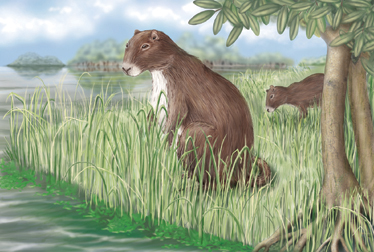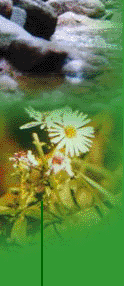|
Reuters
Sep 18 2003 2:25PM
The fossil of a 1,500-pound animal, 9 feet long, belonged to a rodent -- an early ancestor of modern guinea pigs, researchers
reported on Thursday.
Living 8 million years ago in what is now Venezuela, the animal would have grazed and from a distance would have resembled
a buffalo, the researchers report in Friday's issue of the journal Science.
Found in a remote area in 2000, the fossil mystified scientists who finally determined it was a specimen of Phoberomys
pattersoni.
"Imagine a weird guinea pig but huge, with a long tail for balancing on its hind legs and continuously growing teeth,"
research team leader Marcelo Sanchez-Villagra of the University of Tubingen in Germany said in a statement.
At the time the area, 250 miles west of Caracas, was lush, with monster turtles, huge crocodiles and giant catfish in
the rivers.
"Phoberomys is reported to be the largest rodent that ever existed," Sanchez-Villagra and colleagues in Venezuela
and the United States wrote in the report.
"Reliable body mass estimates yield around 700 kg (1,500 pounds), more than 10 times the mass of the largest living
rodent, the capybara."
Capybaras, which live in South America, are sheep-sized rodents that stand fairly upright compared to their smaller, crouching
cousins. Like capybaras, the ancient rodent would likely have lived near water, wading into the shallows to graze, they said.
McNeill Alexander of the University of Leeds in Britain, one of the world's leading experts on animal body size and physiology,
said it is a mystery why and how such huge rodents lived.
Its bones and teeth suggest the animal, nicknamed Goya, munched grass. Like other rodents, its teeth grew constantly as
they were worn down by gnawing and grazing.
Larger animals are more successful grazers, Alexander said in a commentary, perhaps because they have bigger stomachs
to digest their fibrous meals.
"The question that puzzles me is not how Phoberomys could have been so large, but why the overwhelming majority of
rodents are so small," Alexander wrote.
Perhaps they were easier to catch and eat in a time when gigantic animals were common, he said.
"Small mammals commonly escape predators by retiring into a refuge such as a burrow," he added. "Large
mammals, too big to burrow, can generally escape only by running."
While Goya would have had straight legs, unlike a guinea pig, it would not have been fleet of foot.

|




